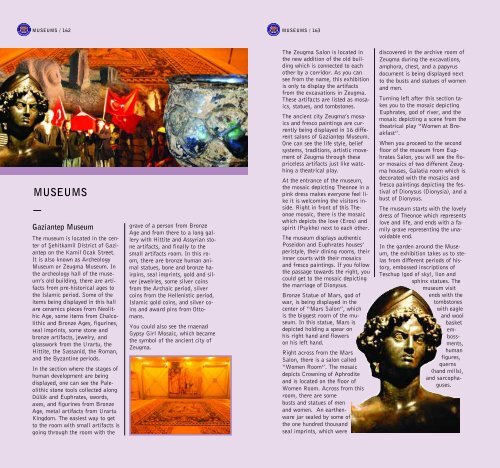You also want an ePaper? Increase the reach of your titles
YUMPU automatically turns print PDFs into web optimized ePapers that Google loves.
MUSEUMS / 162 MUSEUMS / 163<br />
MUSEUMS<br />
Gaziantep Museum<br />
The museum is located in the center<br />
of fiehitkamil District of Gaziantep<br />
on the Kamil Ocak Street.<br />
It is also known as Archeology<br />
Museum or Zeugma Museum. In<br />
the archeology hall of the museum’s<br />
old building, there are artifacts<br />
from pre-historical ages to<br />
the Islamic period. Some of the<br />
items being displayed in this hall<br />
are ceramics pieces from Neolithic<br />
Age, some items from Chalcolithic<br />
and Bronze Ages, figurines,<br />
seal imprints, some stone and<br />
bronze artifacts, jewelry, and<br />
glasswork from the Urartu, the<br />
Hittite, the Sassanid, the Roman,<br />
and the Byzantine periods.<br />
In the section where the stages of<br />
human development are being<br />
displayed, one can see the Paleolithic<br />
stone tools collected along<br />
Dülük and Euphrates, swords,<br />
axes, and figurines from Bronze<br />
Age, metal artifacts from Urartu<br />
Kingdom. The easiest way to get<br />
to the room with small artifacts is<br />
going through the room with the<br />
grave of a person from Bronze<br />
Age and from there to a long gallery<br />
with Hittite and Assyrian stone<br />
artifacts, and finally to the<br />
small artifacts room. In this room,<br />
there are bronze human animal<br />
statues, bone and bronze hairpins,<br />
seal imprints, gold and silver<br />
jewelries, some silver coins<br />
from the Archaic period, silver<br />
coins from the Hellenistic period,<br />
Islamic gold coins, and silver coins<br />
and award pins from Ottomans.<br />
You could also see the maenad<br />
Gypsy Girl Mosaic, which became<br />
the symbol of the ancient city of<br />
Zeugma.<br />
The Zeugma Salon is located in<br />
the new addition of the old building<br />
which is connected to each<br />
other by a corridor. As you can<br />
see from the name, this exhibition<br />
is only to display the artifacts<br />
from the excavations in Zeugma.<br />
These artifacts are listed as mosaics,<br />
statues, and tombstones.<br />
The ancient city Zeugma’s mosaics<br />
and fresco paintings are currently<br />
being displayed in 16 different<br />
salons of Gaziantep Museum.<br />
One can see the life style, belief<br />
systems, traditions, artistic movement<br />
of Zeugma through these<br />
priceless artifacts just like watching<br />
a theatrical play.<br />
At the entrance of the museum,<br />
the mosaic depicting Theonoe in a<br />
pink dress makes everyone feel like<br />
it is welcoming the visitors inside.<br />
Right in front of this Theonoe<br />
mosaic, there is the mosaic<br />
which depicts the love (Eros) and<br />
spirit (Psykhe) next to each other.<br />
The museum displays authentic<br />
Poseidon and Euphrates houses’<br />
peristyle, their dining rooms, their<br />
inner courts with their mosaics<br />
and fresco paintings. If you follow<br />
the passage towards the right, you<br />
could get to the mosaic depicting<br />
the marriage of Dionysus.<br />
Bronze Statue of Mars, god of<br />
war, is being displayed in the<br />
center of “Mars Salon”, which<br />
is the biggest room of the museum.<br />
In this statue, Mars is<br />
depicted holding a spear on<br />
his right hand and flowers<br />
on his left hand.<br />
Right across from the Mars<br />
Salon, there is a salon called<br />
“Women Room”. The mosaic<br />
depicts Crowning of Aphrodite<br />
and is located on the floor of<br />
Women Room. Across from this<br />
room, there are some<br />
busts and statues of men<br />
and women. An earthenware<br />
jar sealed by some of<br />
the one hundred thousand<br />
seal imprints, which were<br />
discovered in the archive room of<br />
Zeugma during the excavations,<br />
amphora, chest, and a papyrus<br />
document is being displayed next<br />
to the busts and statues of women<br />
and men.<br />
Turning left after this section takes<br />
you to the mosaic depicting<br />
Euphrates, god of river, and the<br />
mosaic depicting a scene from the<br />
theatrical play “Women at Breakfast”.<br />
When you proceed to the second<br />
floor of the museum from Euphrates<br />
Salon, you will see the floor<br />
mosaics of two different Zeugma<br />
houses, Galatia room which is<br />
decorated with the mosaics and<br />
fresco paintings depicting the festival<br />
of Dionysus (Dionysia), and a<br />
bust of Dionysus.<br />
The museum starts with the lovely<br />
dress of Theonoe which represents<br />
love and life, and ends with a family<br />
grave representing the unavoidable<br />
end.<br />
In the garden around the Museum,<br />
the exhibition takes us to stelas<br />
from different periods of history,<br />
embossed inscriptions of<br />
Teschup (god of sky), lion and<br />
sphinx statues. The<br />
museum visit<br />
ends with the<br />
tombstones<br />
with eagle<br />
and wool<br />
basket<br />
embossments,<br />
human<br />
figures,<br />
querns<br />
(hand mills),<br />
and sarcophaguses.


